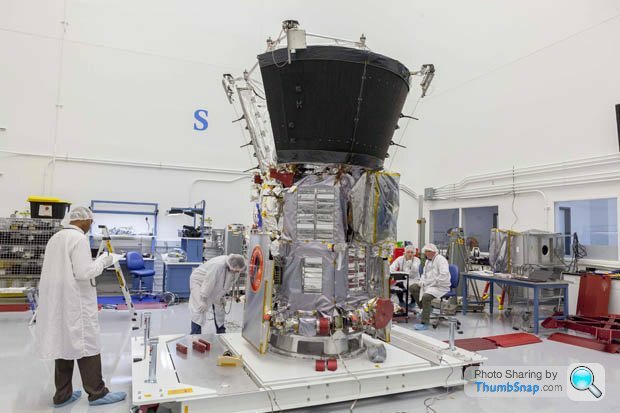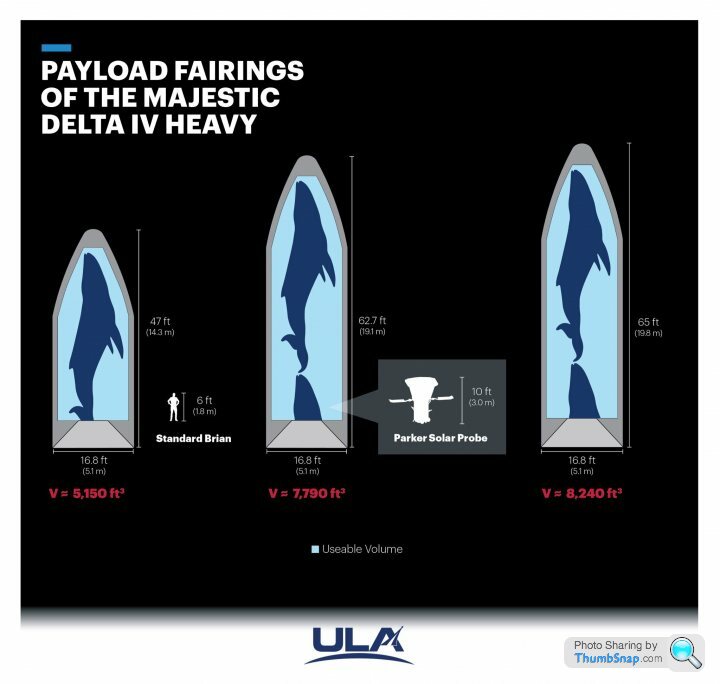Parker Solar Probe
Discussion
NASA's Parker Solar Probe is due to be launched atop a Delta 4 Heavy rocket on Saturday 11th August - from Cape Canaveral (08.48-09.33 UK time) and they're always impressive to see. First one for 2 years too.
The specially shielded probe will fly to 3.8 million miles from the Sun's surface, which is 7 times closer than any other spacecraft ever has. It'll study the solar winds and the surface of the Sun itself while braving intense solar radiation & heat of around 1,300 degrees Celsius.

It's not the largest thing we've ever put into space, but it'll eventually be the fastest man made object, getting up to around 430,000 mph (700,000 kph).
They're going to put it in an orbit between the Sun and Venus, using Venus's gravity to gradually lower the orbit for closer & closer passes of the Sun. This will require 7 passes of Venus over 6 years to bring it down to closest approach through the Sun's corona. This will start in late 2024, but they'll be able to gather data along the way.
https://www.nasa.gov/content/goddard/parker-solar-...
The specially shielded probe will fly to 3.8 million miles from the Sun's surface, which is 7 times closer than any other spacecraft ever has. It'll study the solar winds and the surface of the Sun itself while braving intense solar radiation & heat of around 1,300 degrees Celsius.

It's not the largest thing we've ever put into space, but it'll eventually be the fastest man made object, getting up to around 430,000 mph (700,000 kph).
They're going to put it in an orbit between the Sun and Venus, using Venus's gravity to gradually lower the orbit for closer & closer passes of the Sun. This will require 7 passes of Venus over 6 years to bring it down to closest approach through the Sun's corona. This will start in late 2024, but they'll be able to gather data along the way.
https://www.nasa.gov/content/goddard/parker-solar-...
Edited by Beati Dogu on Sunday 5th August 19:04
More whales & rockets:

With a human and the Parker Solar Probe to scale.
Seems like overkill to launch a diminutive spacecraft on a large $400 million rocket, but the energy requirements of this mission demand it. This particular Delta IV Heavy rocket has a third "kick stage" as well, which will help fire the probe towards Venus.
This will be the fastest object ever to leave the Earth's atmosphere. Beating a record of 36,400 mph set by the New Horizons mission during launch on an Atlas V in 2006.
Somewhat perversely, the high velocity is actually to slow down the spacecraft. The Earth orbits the sun at about 70,000 mph and so effectively does anything we launch. A trip to the Sun and inner planets means reducing that speed somewhat.

With a human and the Parker Solar Probe to scale.
Seems like overkill to launch a diminutive spacecraft on a large $400 million rocket, but the energy requirements of this mission demand it. This particular Delta IV Heavy rocket has a third "kick stage" as well, which will help fire the probe towards Venus.
This will be the fastest object ever to leave the Earth's atmosphere. Beating a record of 36,400 mph set by the New Horizons mission during launch on an Atlas V in 2006.
Somewhat perversely, the high velocity is actually to slow down the spacecraft. The Earth orbits the sun at about 70,000 mph and so effectively does anything we launch. A trip to the Sun and inner planets means reducing that speed somewhat.
Link to the webcast
https://www.space.com/17933-nasa-television-webcas...
Good to see they are going at night so it won't be hot.....
https://www.space.com/17933-nasa-television-webcas...
Good to see they are going at night so it won't be hot.....

Kccv23highliftcam said:
You are indeed a mine of information Eric 
I only know that because, in December 2014, when they were launching the Orion spacecraft on its first test flight atop a Delta IV heavy, a small boat wandered into the "no go" zone off the coast and the launch was put on hold while they cleared the area.
By the time that was done, they had to scrub the launch because some of the components were showing lower than allowed temperatures.
Eric Mc said:
Kccv23highliftcam said:
You are indeed a mine of information Eric 
I only know that because, in December 2014, when they were launching the Orion spacecraft on its first test flight atop a Delta IV heavy, a small boat wandered into the "no go" zone off the coast and the launch was put on hold while they cleared the area.
By the time that was done, they had to scrub the launch because some of the components were showing lower than allowed temperatures.
Gassing Station | Science! | Top of Page | What's New | My Stuff




